By Snorri Páll Jónsson Úlfhildarson, originally published in the Reykjavík Grapevine.
There is a photograph by Richard Peter of a statue of an angel overlooking the card-house-like ruins of Dresden. During three days in February 1945, the German city was annihilated by the allied forces using a new firestorm technique of simultaneously dropping bombs and incendiary devices onto the city.
The photo resonates with philosopher Walter Benjamin’s essay ‘On the Concept of History,’ in which he adds layers of meaning to a painting by Paul Klee titled ‘Angelus Novus’. Benjamin describes Klee’s angel as ‘The Angel of History’ whose face is turned towards the past. “Where we see the appearance of a chain of events, he sees one single catastrophe, which unceasingly piles rubble on top of rubble and hurls it before his feet.”
Wanting to “awaken the dead and to piece together what has been smashed,” the Angel’s wings are stretched out by a storm from Paradise, which “drives him irresistibly into the future, to which his back is turned, while the rubble-heap before him grows sky-high.”
“That which we call progress,” Benjamin concludes, “is this storm.”
Can You Stand in the Way of Progress?
If the storm disenables us to fix the ruins of the past, what about preventing the storm from blowing? That would not be so simple according to art collective Angeli Novi, comprised of Steinunn Gunnlaugsdóttir and Ólafur Páll Sigurðsson, whose exhibition is currently showing at The Living Art Museum (Nýló).
Under a confrontational title — ‘You Can’t Stand in the Way of Progress,’ shaped as the ‘Arbeit Macht Frei’ sign of Auschwitz — Angeli Novi have greatly altered the museum’s space with an installation of sculptures, soundscapes, smells and videos, including a 20-minute film of the same title as the exhibition. The film is a kind of kaleidoscopic time machine, examining the plight of generations which, one after the other, become tools and puppets of economic and historical structures.
In a well-cooked and stark manner — adjectives borrowed from Nýló’s director Gunnhildur Hauksdóttir — often shot through with streaks of black humour, the exhibition displays a dark image of Western civilization via versatile manifestations of the horrors embedded in capitalism, industrialism, nationalism, religion, the dualistic and linear thought of occidental culture, and the individual’s buried-alive position in society.
The metaphor here is literal as the only visible body-parts of the film’s thirty protagonists are their heads. The rest are buried under ground. Between themselves, their chewing mouths fight over ceremonial ribbons carrying a collection of Western society’s fundamental values, doctrines and clichés, in a dynamic collision with a collage of significant images behind them — “the history of Western thought,” as author Steinar Bragi points out. Towering over a coffin shaped as a baby’s cot, located in a mausoleum at the museum’s entrance, the same ribbons have been tied onto a funeral wreath. A single cliché, “From the Cradle to the Grave,” hangs between the mouths of two children’s heads that stick out of the black sand below the coffin. A smooth corporate female voice greets the visitors: “Welcome to our world!”
I Sense, Therefore I Think
“It’s very pessimistic,” Steinar Bragi says during our conversation in a bunker-like room of Nýló. “The film shows us disembodied beasts, fighting over the phrases that our entire society is built upon. I always see the head as the rational approach to life, stuck in these dualistic pairs that are so far from reality as I experience it. We have sensibilities, then emotions, and finally there are words and reason. Reason is useful for certain tasks, when one has to go from place A to place B, but it’s only a tool to be used on something far more extensive.”
Steinar and I agree that society is constantly simplified into Cartesian dualism — “I think, therefore I am” — the ground zero of Western thought. And while dualism doesn’t necessarily reject sensibilities and emotions, Steinar maintains that it locates reason on a higher level. “Reason is expected to control, which it certainly does in a small and unglamorous context, but it’s only an expression of what lies beneath.”
Enemies of Progress?
It’s clear that the core of this rationalism is simplification such as how political and social conflicts tend to be reduced to a fight between alleged good and evil forces. This not only brings us to the religious nature of the myth of progress, but also the power of language. Because “although they are hollow and empty and repeatedly chewed on, these phrases are also very powerful,” as literary scholar Benedikt Hjartarson points out. “They conduct the way society is shaped. They manifest the social and economic reality we live with.”
As former director of US aluminium corporation Alcoa Alain Belda told the newspaper Morgunblaðið in March 2003: “Some people are against progress.” He was referring to the opponents of the Kárahnjúkar dams, constructed in Iceland’s highlands to create energy for Alcoa’s smelter. “But fortunately,” he continued, “the world is growing and people are requesting better lives.”
Such an argument equals economic growth and people’s welfare, portraying the megaproject’s opponents as enemies of progress. At the same time it negates the destructive nature of progress, manifested for instance in the culturally genocidal impacts — in the form of displacement of populations — and irreversible environmental destruction often associated with large-scale energy production, and how the lives of whole generations are wasted by wars waged for power and profit.
“We see this contradiction within modernity,” Benedikt continues, “how the idea of progress thrives on destruction and always calls for annihilation.” But unlike the revolutionary destruction encouraged by 19th Century anarchist philosopher Michail Bakunin — who stated, “the passion for destruction is a creative passion too!” — the annihilation inherent to progress is rather used as a stimulus for an unaltered continuum of the status quo under the pretext of development. Thus, the contradictory nature is evident again, as well as the religious one: “The present is never here,” Benedikt says, “it’s always something we are aiming for.”
Violence Intrinsic to Social Contracts
The film displays a great amount of violence, which musician Teitur Magnússon sees with a strong reference to alienation. “One feels like it’s somehow supernatural, like it’s not the work of humanity but rather of a monster that’s eating everything up, and we don’t seem to have any control of it.”
Artist Bryndís Hrönn Ragnarsdóttir furthermore connects this brutality with authority. “Humans aren’t able to handle more power than over themselves,” she says. “As soon as someone is granted higher power, violence enters the picture.” She maintains that some sort of violence is intrinsic to all simplifications — “all of society’s attempts to try and settle upon something” — meaning a wide range of social contracts, from organized religion to written and unwritten rules regarding people’s behaviour.
A Leap Into the Future
As Angeli Novi’s subject is not only complex but also polarized — layered with our cultural history of construction and destruction, repression and revolt — the exhibition doesn’t preach any simple solutions to the great problems it addresses. Such attempts are often just as contradictory as the myth of progress itself, or as philosopher Slavoj Žižek ironically sums up in his analysis of what he calls ‘a decaf reality,’ when the “very thing which causes damage should already be the medicine.”
Thus, one cannot resist wondering if there actually is a way out of the horrors analysed and manifested in the exhibition. Or is humanity bound to be stuck in a premature burial while the seemingly unstoppable catastrophe witnessed by Benjamin’s Angel of History keeps on enlarging into eternity?
With images referring to France’s July Revolution of 1830, Angeli Novi reject such a vision and suggest instead a peculiarly creative approach to revolt. Already during the revolution’s first day, clocks on church towers and palaces all over Paris were shot down and destroyed, signifying the urgent need to nullify predominant social structures and ideologies by putting an end to the time of the oppressors.
In continuum of this rebellious tradition of what philosopher Herbert Marcuse referred to as “arresting time” — directly related to what William Burroughs called “blowing a hole in time” — Angeli Novi transcend the well known demand for “all power to the people” with a leap into the future, granting wings to the mind and calling for all power to the imagination.
_______________________________________________________________
See also:
Saving Iceland: Kárahnjúkar Dam Blown Up in New Film by Angeli Novi
Jón Proppé: Standing in the Way of Progress
Þóroddur Bjarnason: Jafnvægislist (Icelandic only)
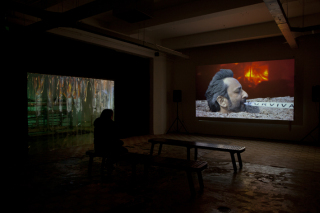
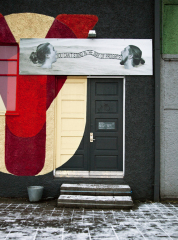
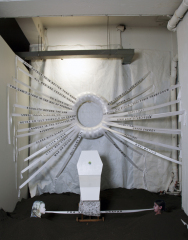
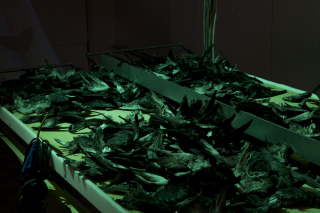
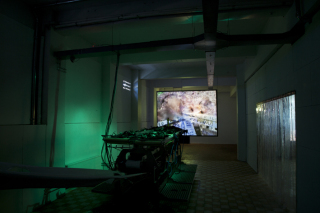
Angeli Novi have been nominated for the 2012 D.V. awards for the visual arts. The awards will be announced on March 13 at a ceremony in Iðnó Theatre in Reykjavik.
A statement from the selections committee of the awards reads thus:
“Angeli Novi achieved with their exhibition [You Can’t Stand in the Way of Progress] on show this autumn in The Living Art Museum, what no one else in the field of visual arts has managed so far, which is to create work that tackles in a thoughtful way the economic and political crisis that happened here [in Iceland] in 2008.Their exhibition was acute and in many ways difficult – as good political art ought to be – but nowhere did they compromise when it came to aesthetic thought or the symbolic execution of the works. ”
http://angelinovi.com/?page=news&id=angeli-novi-nominated-for-dv-awards-in-visual-arts
A trailer of the Angeli Novi film You Can’t Stand in the Way of Progress can now be viewed on AngeliNovi.com